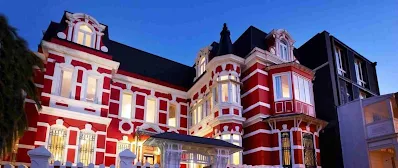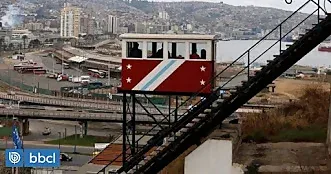- Get link
- Other Apps
Note: In February 2024, some places in central Chile suffered significant damage from devastating fires, including certain areas of Valparaiso. Reconstruction will take a long time and tourism could be restricted in some spots.
______________
The city of Valparaiso, capital of the homonymous region, is one of the most important commercial and military ports in Chile. It is located 116 km NW of Santiago, the national capital. The port city is characterized by its rugged geography and the idiosyncrasy of its inhabitants, it has also been the source of inspiration for many songs about its hills, the beautiful "porteñas" (women of Valparaiso) and all kinds of life stories.
Valparaiso has more than 300,000 inhabitants, making it the third largest city after Santiago and Concepcion, but Greater Valparaiso, which includes the neighboring municipalities currently connected, reaches a population of over one million inhabitants, the second urban center in Chile.
The city is also called "Pancho" and "La Joya del Pacífico" ("The Jewel of the Pacific") by its inhabitants, due to its seascape, history and picturesque architecture, with houses built on dozens of hills. During its greatest splendor in the second half of the 19th century, Valparaíso was also known among sailors as "Little San Francisco". The city was declared a World Heritage Site by UNESCO on July 2, 2003.
One of the most emblematic buildings in Valparaiso is the seat of the Congreso Nacional, which was moved here during the military government to give more importance to the regions. However, this has been controversial because the legislature and the government are located in different cities. As an important commercial and military port, Valparaiso is also home to the headquarters of the Chilean Navy and numerous organizations related to maritime life.
In terms of weather, the city has a Mediterranean climate with mild and sometimes rainy winters and extremely dry summers, which often lead to forest fires. The average annual temperature is 14°C. Below is a list of interesting places to visit in Valparaiso.
Hills of Valparaiso
The chain of more than 40 hills that surround its bay is one of the city's quintessential postcard images, its architecture uniquely adapted to the steep slopes. These hills, the port's hallmark, are actually different areas of the same mountain range. Among the most representative "cerros" (hills) are:
Cerro Concepcion, whose name comes from the ancient fort that stood there for the defense of the city. The old buildings show the influence of the first European settlers who arrived in the area. Cerro Concepcion was chosen by the German immigrants who are responsible for the current urban layout of this area, highlighting its viewpoints, beautiful gardens and elegant mansions.
Cerro Concepcion, whose name comes from the ancient fort that stood there for the defense of the city. The old buildings show the influence of the first European settlers who arrived in the area. Cerro Concepcion was chosen by the German immigrants who are responsible for the current urban layout of this area, highlighting its viewpoints, beautiful gardens and elegant mansions.
One of the neighborhood's highlights is St. Paul's Anglican Church, constructed by English engineer William Lloyd in 1858, marking the colony's first Anglican place of worship in Valparaiso. The Lutheran Church of Valparaiso, built by Germans in 1897, is nearby. Other notable attractions include the Ascensor Concepcion, Valparaiso's inaugural funicular from 1883, scenic viewpoints overlooking the bay, and iconic spots like "Paseo Atkinson," "Paseo Gervasoni," and "La Casa de Lukas," showcasing the works of renowned Chilean cartoonist Renzo Pecchenino, known as "Lukas." Galvez, Fischer, and Templeman alleys add to the area's charm.
 |
A view of Hotel Palacio Astoreca
Cerro Alegre |
Among the typical places of the hill we can mention Palacio Baburizza, a historical monument built in 1916, located in Paseo Yugoslavo of Cerro Alegre, whose name comes from its second owner, a Croatian entrepreneur of the first half of the twentieth century. The house became the Municipal Museum of Fine Arts of Valparaiso in 1971. Next is the Victorian-style Palacio Astoreca, built in 1923 by the Croatian immigrant Francisco Petrinovic, who made his fortune during the golden age of saltpetre. Today, the palace has been transformed into a luxurious boutique hotel.
Cerro Bellavista, owes its name to the beautiful view it offers over the Bay of Valparaiso. Cerro Bellavista was chosen to create the Museo a Cielo Abierto de Valparaiso, outdoor tour to admire 20 street art murals so far, by renowned artists who have visited the city. You can hire guided tours to see the murals and graffiti of the hills, so visitors can observe in detail the dozens of these works and even paint their own creations. In Cerro Bellavista is also the Cristo Redentor (Christ the Redeemer), inaugurated in 1904 and destined to protect the port. This sculpture is attributed to Eduardo Provasoli, a famous Italian architect of the time who designed several churches throughout Chile.
Cerro Artilleria, another hill that stands out for its incredible architecture of houses that seem to hang from the side of the hill. Its name comes from the artillery barracks located at the top. Among the attractions are the Museo Maritimo Nacional, Paseo 21 de Mayo, one of the many natural viewpoints of Valparaiso, the Artilleria and Villaseca funicular railways, handicraft fairs, Casa Artilleria No. 156 (or Casa Cuatro Vientos), old house built between 1908 and 1909 by Italians Renato Schiavon and Arnaldo Barison, one of the most photographed places in Valparaiso because of its location.
Cerro Baron, at the eastern end of the "Plan" (lower part of the city). On this hill stands the "Iglesia de San Francisco" (San Francisco Church), a temple full of history that has suffered at least two major fires. The San Francisco Church gives Valparaiso the nickname "Pancho", because in the past this temple was the most recognizable point for sailors arriving at the port. (Spanish, name Francisco = nickname "Pancho").
Nearby is El Almendral neighborhood, with many important places such as the National Congress, the Municipal Theater, the Cathedral, Plaza Victoria, the Church of the Twelve Apostles, O'Higgins Square, the Mercado Cardonal, whose two-story meccano-style building dates from 1912. It was designed by Eduardo Feuereisen, a disciple of Alexandre Gustave Eiffel; Palacio Polanco, used since 1942 as the headquarters of the Prefecture of the Carabineros de Chile, and many other interesting places.
Funicular Railways of Valparaiso
 |
| Image: biobiochile.cl |
Other important "ascensores" of Valparaíso are the Ascensor Artilleria, from 1893, built to transport officers and sailors of the Naval Academy, its cars are the largest and interesting for its colorful painting, including modern designs. Its upper station is located at Paseo 21 de Mayo, one of the main viewpoints of the city. Ascensor Baron, since 1906, located in the homonymous hill, connects Avenida España in the lower part of the city with Avenida Diego Portales at the top, Baron was the first funicular to work with an electric motor, thus replacing the old system of water counterbalance. As we said before, the Ascensor Polanco is the only real elevator of Valparaiso. It is also very original because its entrance is preceded by a tunnel of 150 mts. long that reminds an old abandoned silver mine.
Ascensor Reina Victoria, at Cerro Alegre, built in 1902 and declared Historical Monument in 1998, so named in honor of Queen Victoria of the United Kingdom, who died in 1901, one year before its construction. Its route is very short, only 40 meters, but the gradient is very steep, 52°. Ascensor El Peral, since 1901, connects the Plaza de Justicia in the lower part of the city with the Paseo Yugoslavo in Cerro Alegre, one of the most important tourist areas of Valparaiso, with a stunning panoramic view of the city and where the Palacio Baburizza is located, seat of the "Museo Municipal de Bellas Artes", the main pictorial art gallery of the city.
A must see are the miradores nestled in its many hills to take beautiful pictures and admire the port city, the most visited because of its strategic location:
Paseo Atkinson, located in Cerro Concepción, along a beautiful row of gardens of old large houses belonging to the nineteenth century. Paseo Atkinson is constantly visited by national and foreign tourists, attracted by the special view, arrangement and maintenance of the large houses.
Paseo Gervasoni, is next to Paseo Atkinson. It has a great view of the bay and is surrounded by big houses from the 19th century. It also has the Casa-Museo of Renzo Pecchenino, Café Turri, and Hotel Gervasoni, which is the oldest building in the area.
Paseo Yugoslavo, is one of the first promenade viewing platforms in Valparaiso. It is located above Plaza Sotomayor, one of the city's main squares. It is a popular spot for tourists because it offers great views of the port and the entire "plan" (sea level part of the city). Here is Palacio Baburizza, currently converted into Valparaiso's Fine Arts Museum.
Paseo 21 de Mayo, traditional and attractive promenade located at Cerro Artilleria, visited daily by tourists from all over the world, is one of the most important places of interest of Valparaiso to get an excellent view of the port and the city, easy and fast to reach from downtown.
Boat Tours
One of the attractions of the country's main port is its bay and the panoramic views of the city from the coast.Either at the port or through local agencies, you can take a boat trip in colorful boats that offer trips around the bay to observe marine fauna, merchant and war ships, all the port activities and the city. The tours last about 30 minutes and depart from Muelle Prat.
"La Sebastiana" House - Museum
.webp) |
| "La Sebastiana" |
One of the houses where the famous Chilean diplomat, writer and poet Pablo Neruda, Nobel Prize for Literature, lived for periods. The name was given by Neruda in honor of his friend and first owner, the Spanish architect Sebastian Collado.
"La Sebastiana" is located at 692 Ricardo de Ferrari Street, La Florida Hill (Cerro Florida), the museum has a system of audio guides available in English, French, Portuguese, German and Spanish. During the 1973 coup d'état, the house was badly damaged in the raids and for 18 years "La Sebastiana" became a ghost house. From the 90's the house was restored with the help of Telefonica of Spain and opened to the public as a house museum on January 1, 1992. It is a 5-story architectural work with spectacular views, housing the artist's collections and curious objects brought from all over the world. ("La Sebastiana", see more...)
Museo Maritimo Nacional de Chile
Chile's coastline is more than 4300 km long, so the history of the country and the life experiences of its people are closely related to the sea.Located in the facilities of the former Escuela Naval (Naval Academy) on Artilleria Hill, its mission is to preserve and promote the history of the Chilean Navy through the exhibition of various objects such as models of ships, weapons, uniforms, flags, logbooks, letters and many valuable documents and relics. Its collections include more than 3,000 three-dimensional objects, and in terms of literature and documents, there are more than 30,000 volumes.
Museo Municipal de Bellas Artes de Valparaiso
It is the most significant pictorial exhibition in this important region of Chile. Since 1971, it has been housed in Palacio Baburizza, a building dating back to 1916 and once owned by the Croatian businessman Pascual Baburizza. The palace is situated on Paseo Yugoslavo in Cerro Alegre. The museum showcases significant collections of Chilean and European paintings from the 19th and 20th centuries, with pieces collected since 1895. Today, it is ranked among the four most important art collections in Chile.
Museo de Historia Natural de Valparaiso
 |
| Image: registromuseoschile.cl |
Other places to visit:
- Get link
- Other Apps
%20(1).webp)
.webp)
Comments
Post a Comment